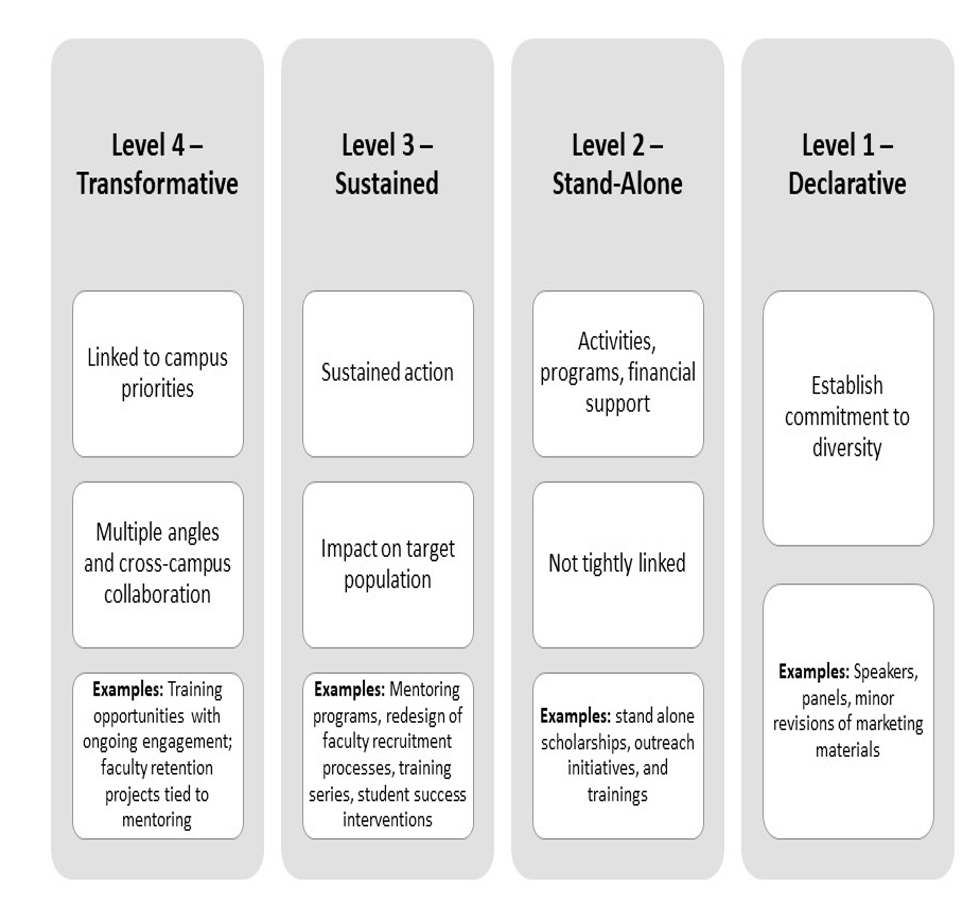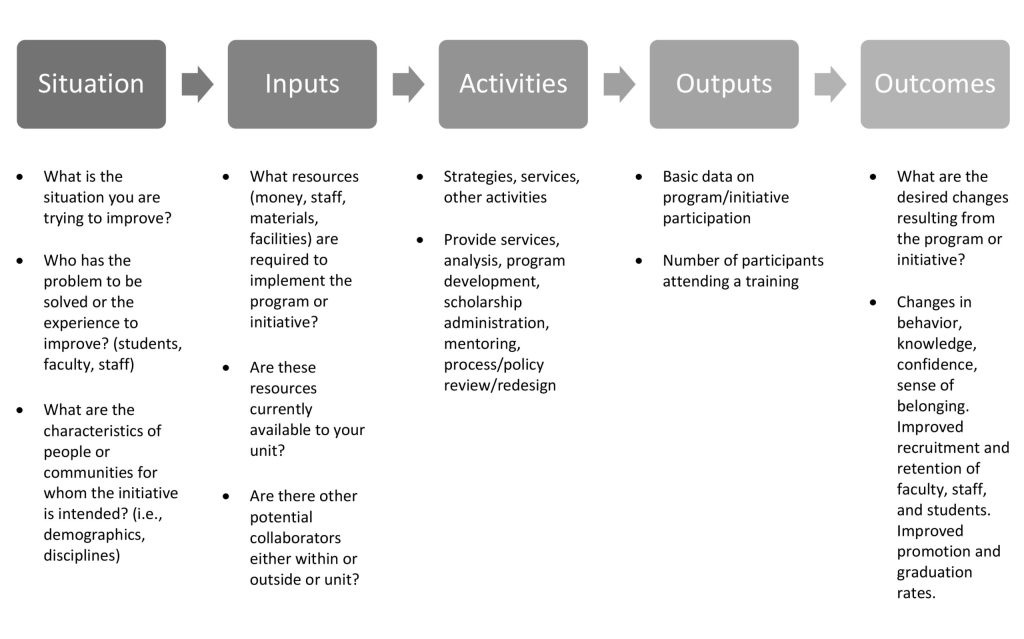The goal of Inclusive Excellence is to merge quality and diversity, inclusion, and equity so that we design our operations and educational processes to continuously improve the experiences and outcomes for underserved and marginalized students, faculty, and staff.
Campus Priorities from Strategic Plan
- Student Success
- Faculty Recruitment/Retention
- Education & Scholarship
- Inclusive Teaching
- Inclusive Research
- Professional Development
In 2019, the Division of Inclusion, Diversity & Equity (IDE) had the opportunity to reflect on the impact of MU’s Inclusive Excellence efforts since 2017. In collaboration with liaisons in each campus unit, and the University of Missouri System, IDE has identified strategic priorities for the next phase of MU’s adoption of the Inclusive Excellence Framework.
This phase focuses on efforts likely to have a substantial and sustained impact on experiences and outcomes for MU community members from underrepresented groups. Additionally, this phase strengthens IDE’s collaborations with individual units as well as collaborations between units working on similar issues.
In an effort to ensure sustained impact of inclusive excellence, IDE and the UM System are asking units to identify significant barriers to achieving the goals outlined in the campus strategic plan.
Therefore, unlike the first round of IE planning, units should not outline every possible initiative but should provide plans that are tightly focused on addressing the university’s biggest gaps in performance, equity, access, and success.
For assistance with your unit’s planning efforts please see our IDE contacts below.
Suggested Process
- Gather a planning team of about five people – should include students, faculty and staff
- The team should have at least one person with experience in work or research related to inclusive excellence.
- Review your unit’s existing data and initiatives (See Self-Study Worksheet)
- Identify desired unit outcomes for each University Priority.
- Assess your unit based on each University Priority.
- Review unit goals related to each priority and make updates if needed (goals should be Specific, Measurable, Attainable, Relevant, and Time Bound).
- Identify current initiatives related to each priority.
- Categorize current unit initiatives by Inclusion Effort Levels 1-4 (see Rubric below).
- Identify gaps between unit goals and current state (see Metric toolkit).
- Analyze the balance of Inclusion Effort Level ensuring that most initiatives are at Level 3 and 4.
- Analyze Unit Capacity Level.
- Review literature related to gap areas.
- Develop initiatives using the IDE Logic Model Template and the Inclusive Excellence Plan Template.
- Use Inclusion Effort Level and Unit Capacity Level rubrics to evaluate the strength of your IE plan.
- Prepare proposals for initiatives for which you intend to seek UM System funding.
- Consult with the Office of Inclusive Excellence for resources or support as needed.
Inclusion Effort Level

A key distinction between the effort levels is the degree to which there are linkages between initiatives. A mentoring program, for example, might fall anywhere between level 2 and 4 depending on the context and implementation. The existence of a mentoring program alone is a level 2 initiative. A mentoring program tied to academic support and/or scholarship funding specifically targeting underrepresented/underserved groups rises to a level 3 or 4 depending on the program’s connection to robust evaluation and sustainability over time.
Unit Capacity Level
Low Capacity
- Many of the unit’s Inclusive Excellence plan efforts are unrelated to campus priorities.
- Weak or non-existent assessment and evaluation mechanisms (aggregated, non-specific).
- Does not identify the problems they are attempting to solve.
- No or little evidence of trust-building across stakeholder groups.
Moderate Capacity
- The unit’s IE initiatives are linked to each other and to University Strategic Priorities.
- Leaders exhibit knowledge of diversity and inclusion practices. They provide evidence of deep engagement of stakeholder groups to develop and evaluate the IE plan.
- They actively build trust across stakeholder groups.
- Metrics and indicators are directly tied to initiatives.
- The plan involves active disruption of oppressive practices and systems.
Inclusive Excellence Plan Template
Each unit will receive an Excel file with the following columns:

Additionally, please detail your unit’s barriers to achieving the priorities outlined in the campus strategic plan.
Note: We suggest using this template to develop and maintain your overall Inclusive Excellence Plan, however, you should only submit initiatives that address University IE Priorities.
Introduction to Logic Models
Logic models are a concise and visual way to create shared understanding of the relationships among the resources you have to implement your Inclusive Excellence initiatives, the activities needed to carry out the initiative, and the impact you hope to attain. A logic model is a series of if-then relationships. If we invest these inputs/resources, then these activities can occur. Logic models:
- Make assumptions explicit.
- Create shared understanding and helps develop expectations.
- Identify needed data and key evaluation questions.
- Clarify the nature of the problem to be solved for stakeholders.
Logic models have four general components:
- Identify the long-term outcomes of your initiative: Changes in the life state experienced by the served population.
- Identify initial and intermediate outcomes of the initiative: Changes in knowledge, skill, or quality of experience/belonging.
- Identify the activities that need to occur to achieve desired outcomes.
- Identify the inputs (material, human, financial) needed.
- Identify the outputs: What will your initiative deliver?
IDE Logic Model

References and Resources
- Rubric references:
Inclusive Excellence Contacts
These individuals are available to assist you with questions as you develop your plan and can connect you with other campus partners working on these issues. If discrimination or harassment allegations arise, the contact will inform the Office of Institutional Equity.
Associate Vice Provost for Academic Access and Leadership Development
Student Support, including:
Assistant Provost for Strategic Faculty Initiatives
Faculty Recruitment and Retention